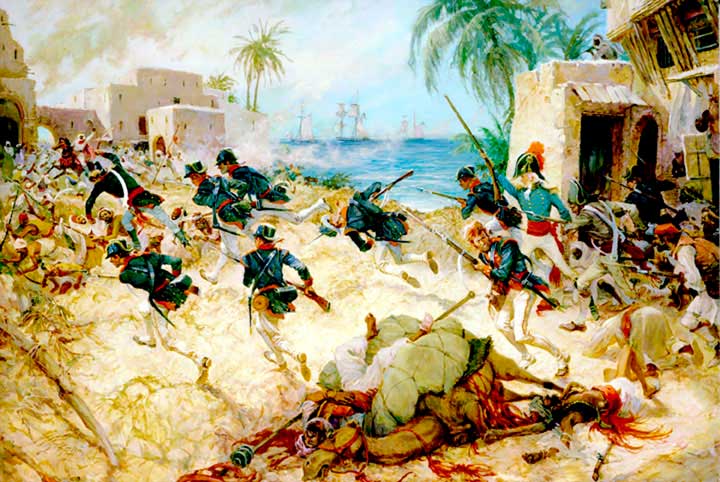
William Bentinck
Occasionally real life figures make an entrance in my historical romances. To me it seems an additional way to place my fictional characters in the living world of their time.
Dark Heart includes an appearance by the Bishop of Interamna who was one of history’s three St. Valentines. There was a role for British Prime Minister William Pitt thre Younger in Moonstone Obsession. In Warrior’s Surrender, I briefly featured William Wallcher, the real life Bishop of Durham.
In Captive of the Corsairs, the real life personality is lieutenant-general William Bentinck, commander of the British troops in Sicily. He features strongly in several scenes with both Captain Kit Hardacre and Sophia Green.
Kit is something of a thorn in Bentinck’s side but is tolerated because his activities around the Mediterranean provide valuable intelligence for Bentinck’s own use as well as that of British interests.
The thorny relationship between the captain and commander mirrors Bentinck’s real life relations with his own government.
William Bentinck was something of a maverick. He joined the Coldstream Guards in January 1791 at the age of 16, purchasing an ensign’s commission. By 1798, he was a colonel in the 24th Dragoons. Five years later, he was appointed Governor of Madras and continued to rise in ranks but his governorship ended in recall to England in 1807 after his order that native troops not wear their traditional uniforms sparked a mutiny.
By 1811, he was commander of British troops in Sicily, British representative to the Court of Palermo, and a lieutenant-general. He immediately began involving himself in internal Sicilian affairs. He butted heads with the former Archduchess Maria Karolina of Austria, by then Queen of Naples-Sicily, who dubbed him La bestia feroce (the ferocious beast).[/vc_column_text][vc_column_text]
[/vc_column_text][vc_column_text]Bentinck was sympathetic to the Sicilians and also visualised a unified Italy in the future. In 1814, he landed with British and Sicilian troops at Genoa, making liberal proclamations of a new order in Italy. However, this embarrassed the British government because it sided with Maria Carolina and wanted to give much of Italy to Austria. Bentinck was recalled to England yet again in 1815.The correspondence Bentinck shoved aside bore the royal crest of Maria Carolina, Queen of Naples and Sicily. She called Bentinck ‘the Beast’, and he had an equally viperous name for her. Kit had it in him to feel sorry for the man. He had overheard a conversation that suggested Bentinck had right royal problems with his own monarchy thanks to his ill-considered expedition to interfere in the politics of Genoa.
If Kit had been one of Bentinck’s subordinates, he’d be quaking in his boots at the murderous expression cast his way. The mountains of Vesuvius couldn’t erupt so spectacularly. Perhaps it wasn’t wise to poke the bear.
“I had an official complaint this morning from the Ottoman envoy over your behaviour at the reception.”
– Captive Of The Corsairs
Surprisingly, in 1828 he was appointed Governor-General of Bengal. Unsurprisingly, he began to meddle again.

Detail from the painting Suttee by James Atkinson (1780–1852) (c) British Library Board 2009 (F165)
Reforming the court system, he made English, rather than Persian, the language of the higher courts and encouraged western-style education. He allied with Indian social reformer Raja Ram Mohan Roy, who objected to practises such as caste rigidity, polygamy, child marriage, and sati, the prescribed death of a widow on her husband’s funeral pyre.
Bentinck passed the Bengal Sati Regulation banning its practice in 1829. (Today, western post-modernists cast the ban as faux outrage at the treatment of women abroad to deflect from subjection of women at home, pointing out that English widows did not fully secure control of their own property until 1882. However, this downplays the work of Raja Ram Mohan Roy against sati prior to Bentinck’s involvement. Moreover, English wives were not expected to kill themselves when their husbands died!)
Bentinck returned to Britain in 1835 and died in June 1839. He had been married to Lady Mary Acheson, daughter of the 1st Earl of Gosford, since 1803. She died in 1843.[/vc_column_text][/vc_column][/vc_row][vc_row padding=”0″][vc_column width=”1/2″][vc_single_image image=”2419″ img_size=”full”][/vc_column][vc_column width=”1/2″][vc_column_text]
Created for book lovers
Join Elizabeth’s Library Book Club today for free reads, exclusive excerpts, competitions and more![/vc_column_text][mk_button corner_style=”rounded” size=”medium” url=”http://box5218.temp.domains/~lizabga3/index.php/homepage/book-club/” target=”_blank” align=”center” margin_top=”6″ animation=”fade-in” bg_color=”#ff0202″]Join Now!
[/mk_button][/vc_column][/vc_row]

